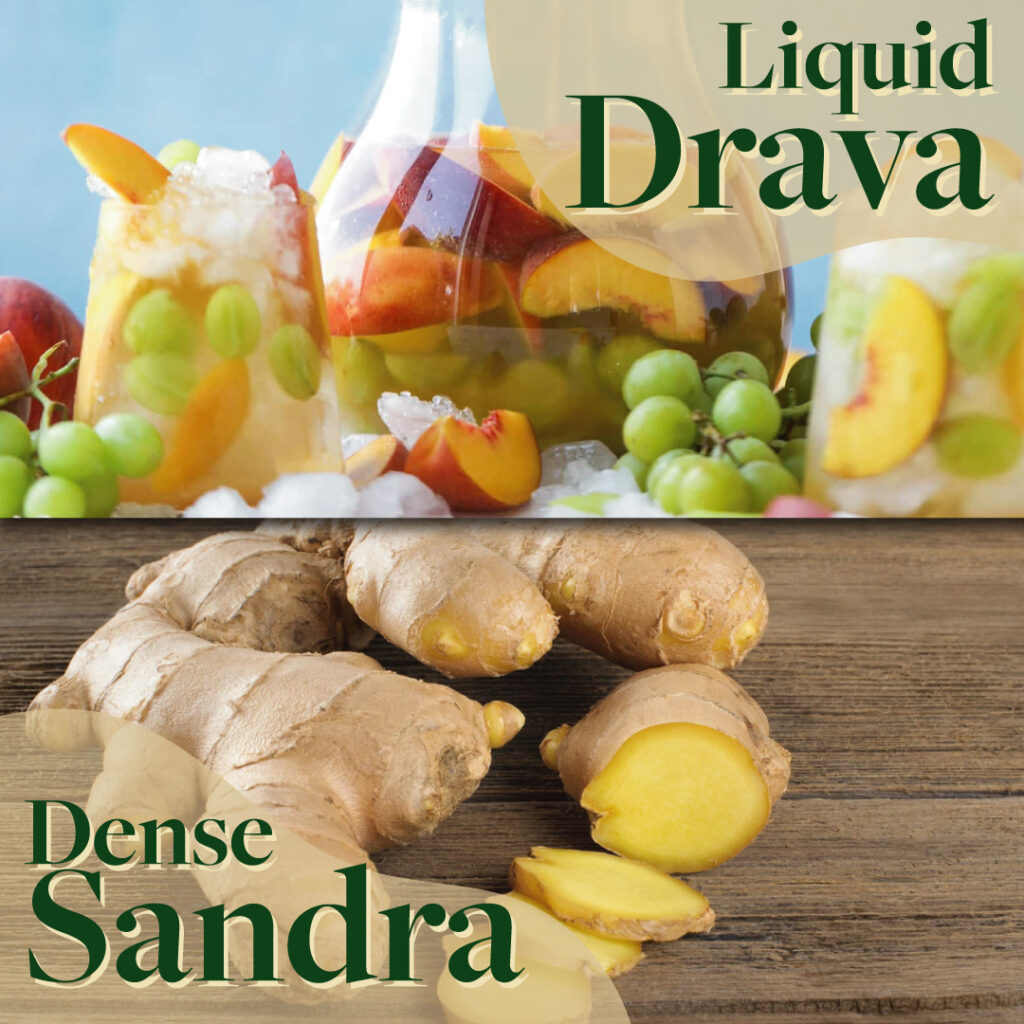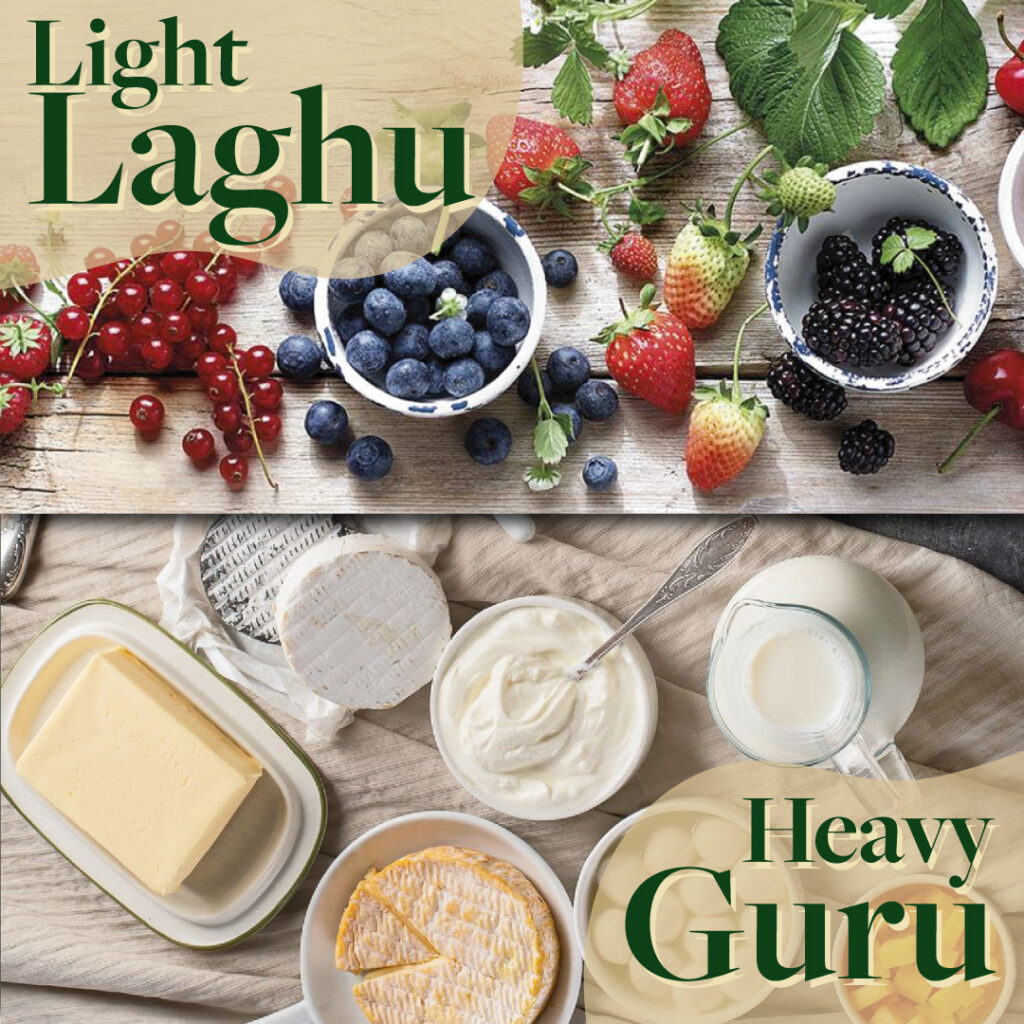‘Gunas’ means quality or attributes. These qualities define us, our universe and everything within the universe. Ayurveda uses twenty qualities or ten pairs of opposites to describe the characteristics and nature of all things in the universe. These are not just limited to food but can also describe qualities, seasons, matter and the universe.
Ayurveda considers that all substances are made of varying proportions of the five elements, and their composition reveals which qualities or Gunas they possess. This not only helps us better understand their physical nature but also helps us understand how to interact with the environment and everything around us.
If a certain substance has a dominant Guna, consuming that substance increases that specific Guna is us and vice-versa. For example, consuming chillies which have the Gunas of ‘Hot’ and ‘Sharp’ would increase those qualities in us by consuming it. It is by understanding these qualities that we can also treat and manage health conditions in our body.
Let us look at 20 Gunas mentioned in Ayurveda and their relationship with the doshas in more detail.
The Common Gunas
Heavy – Light
Heavy (Guru): Heavy quality tends to decrease both the Vata and Pitta Doshas and increase the Kapha Dosha. Guru, meaning dense, takes a considerable amount of energy to digest but also increases bodily tissues. If heavy foods are consumed regularly, it can weaken the Agni, the digestive metabolic fire. Heavy quality substances include foods like milk, wheat, meat, cheese, buttermilk, brown rice, etc.
Light (Laghu): The Light quality tends to increase the Vata and Pitta Doshas and decrease the Kapha Dosha. Foods with ‘light’ quality are generally easy to digest and bring about a feeling of lightness to the body. Since it is the opposite quality to ‘heavy’, individuals suffering from obesity would benefit from taking ‘light’ quality substances. Lightness also tends to increase attentiveness and concentration however, excess consumption of light substances can also create spaciness and ungroundedness manifesting in feelings of fear, anxiety, uncertainty, and insecurity.
Light quality foods include berries, apples, cherries, rice-cakes, celery, corn, lettuce, artichoke, etc.
Cold – Hot
Cold (Sheeta): the water element tends to be exclusive to cold qualities, therefore increasing the Vata and Kapha Doshas and decreasing the Pitta Dosha.
Substances with cold qualities have constricting and contracting effects on the body, which increases the compactness of bodily tissue. Foods that promote ‘Sheeta’ include wheat, milk, grapes, avocado, lime, celery, cabbage, herbs like neem, mint, juices, etc.

Hot (Ushna): predominantly composed of the fire element, creates a burning sensation and heat within the body, leading to an increase in the Vata and Pitta Doshas and a decrease of the Kapha Dosha.
The hot quality gives a therapeutic effect, usually manifesting in perspiration. It also helps relax by expanding channels and facilitating passage and movement within the body. It also enables the removal of waste from the body due to an increase in Agni or digestive fire.
Foods that promote ‘Ushna’ include garlic, ginger, black pepper, mustard seeds, chilli Peppers, alcohol, salt, onion, beef, honey, brown rice, lemon, etc.
Dry – Oily
Dry (Ruksha): predominantly composed of the air element, increases the Vata Dosha and decreases the Pitta and Kapha Doshas. Dry substances have the ability to absorb, and therefore create dryness and hardness within the body. ‘Dry’ also helps to loosen the body but also an excess of dryness can cause dehydration and exhaustion.
Dry quality substances include rice-cakes, dry oats, broccoli, cabbage, celery, fresh corn, kale, cauliflower, honey, etc.

Oily (Snigdha): predominantly composed of the water element, Snigdha increases Pitta and Kapha Doshas and decreases the Vata Dosha. Substances having an Oily quality strengthen body tissues given the similar consistency of oil and tissues. They also provide lubrication and compactness for the tissues, which in turn strengthen the body.
Oily quality substances include ghee, oil, fats, avocado, pork, black olives, warm milk, pomegranate, etc.
Dull – Sharp
Dull (Manda): predominantly composed of the Water and Earth elements, reduces the Vata and Pitta Doshas, and increases the Kapha Dosha. Due to the heavy nature of water and earth, substances with Manda tend to cause dullness and sluggishness in the system.
Rich and fatty foods including milk, yogurt, meat, nutmeg possess ‘Manda’.

Sharp (Tikshna): predominantly from the Fire element, increases the Pitta Dosha and reduces the Vata and Kapha Doshas.
Substances with sharp penetrating qualities tend to coexist with hot qualities and together create cleansing effects on the body, known in Sanskrit as Shodhana. Sharp qualities provide the ability to penetrate and help to reduce any excess Kapha accumulated in the body. Foods with this quality also help in sharpening the intellect thereby improving learning, concentration, and understanding.
Sharp quality foods include spices, salt, pineapple, chillies and honey.
Smooth – Rough
Smooth (Shlakshana): predominantly composed of the Water element, increases the Pitta and Kapha Doshas and reduces the Vata Dosha. Foods that have a ‘smooth’ quality improves lubrication and flexibility within the body. Shlakshana also imbibes the quality for love, care and healing
Substances with smooth quality include talcum powder, oil and avocado.

Rough (Khara): predominantly composed of the Air element, increases the Vata Dosha and reduces the Kapha and Pitta Doshas. Rough substances tend to reduce and deplete bodily tissue. Medicinally, ‘rough’ quality helps remove excess oiliness in the body however, excess dryness can cause dryness leading to dehydration and constipation.
Foods having ‘rough’ quality include biscuits, raw vegetables, cabbage, apples, broccoli, artichoke, black beans, raw carrots, etc.
Dense – Liquid
Dense (Sandra): composed of the earth element, increases the Kapha Dosha and reduces the Vata and Pitta Doshas. Because of their concentrated nature, they promote groundedness and stability. They also promote solidity and growth of healthy tissues.Substances with dense quality include cheese and roots.

Liquid (Drava): Drava is the opposite of Sandra hence it means less concentrated or diluted. Composed of the fire and water elements, increases the Pitta and Kapha Doshas and reduces the Vata Dosha. Drava provides hydration which moistens the body and facilitates the excretion of waste.
‘Drava’ substances include water, yogurt, cherries, grapes, peaches and sweet berries.
Soft – Hard
Soft (Mrudu): composed of the water element, increases the Pitta and Kapha Doshas and decreases the Vata Dosha. ‘Soft’ creates tenderness and relaxation and just the thought of sleeping on soft, nice, fluffy pillows can create thoughts of comfort. However, an excess of soft quality not only increases mucus and phlegm but also flaccidity dislocation of joints.
Foods having ‘soft’ quality include avocado, cucumber, green bananas, sweet potato, white rice and red lentil

Hard (Kathina): composed of the Earth element, increases the Vata and Kapha Doshas and reduces the Pitta Dosha. ‘Kathina’ creates firmness and stability however an excess can increase insensitivity in the body and mind.
Substances having ‘hard’ quality include almonds, sesame seeds and nuts.
Stable – Moving
Stable (Sthira): composed of the Earth element, increases the Kapha Dosha and reduces the Vata and Pitta Doshas. Substances with “Stable” quality provide support and stability. Substances with Stable quality include Yam, wheat and rice flakes.

Moving (Chala): ‘Moving’’ quality provides the action of stimulation and excitation. Composed of the Air element, increases the Vata and Pitta Doshas and reduces the Kapha Dosha. It encourages mobility and change and also facilitates the excretion of bodily waste. However, excess movement can cause restlessness. Foods having ‘Chala’ quality include coffee, spices and chillies.
Gross – Subtle
Gross (Sthula): composed of the Earth element, increases the Kapha Dosha and reduces the Vata and Pitta Doshas. The action and effect of substances with gross quality support and protect the body. However, gross qualities do not move easily and do not penetrate deep in the tissue and therefore have the tendency to block channels. “Gross” substances are difficult to digest and can lead to obesity.
Substances having ‘gross’ quality include meat, Shilajit and mushroom.

Subtle (Sukshma): composed of the Ether and Air elements, with a hint of the Fire element, increases the Vata and Pitta Doshas and reduces the Kapha Dosha.
Subtle quality can penetrate deep small channels within the body reaching the smallest of all bodily tissues. Foods with ‘subtle’ qualities are easy to digest and can expand awareness and open spiritual dimensions. However, excess intake of subtle substances can cause depletion of bodily tissue or also cause spaciness in the mind.
Foods having ‘Sukshma’ include Brahmi, ghee, honey, alcohol, etc.
Cloudy/Sticky – Clear
Cloudy (Pichchila): composed of the water element, increases the Kapha dosha and reduces the Vata and Pitta Doshas. Substances with cloudy or sticky properties tend to increase attachment and cohesiveness. In the mind, they cloud perception and inhibit clear thinking.
Substances having ‘Pichchila’ include milk and dairy products

Clear (Vishada): composed of Ether and Air elements, increases the Vata and Pitta Doshas and reduces the Kapha Dosha. The ‘clear’ quality provides the action of cleansing the body. The clear quality also helps bring clarity to the mind. Excess clear quality can cause the depletion of bodily tissue.
Substances that enhance clarity or Vishada include Brahmi, neem, turmeric, shilajit, etc.
Join us to read more of such articles and support our mission of mindful living for the modern world by subscribing to our blog and hitting us a follow on Instagram and Facebook @sarvedalife.




